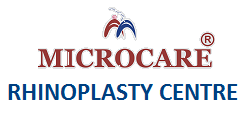Open Rhinoplasty :
The incision type that the rhinoplasty surgeon uses classifies the rhinoplasty as open or closed. In open rhinoplasty, the surgeon makes a small incision in the columella between the nostrils and then makes additional incisions inside the nose whereas in closed rhinoplasty, incisions are made only in the interior of the nose.
 Ever since Rethi first introduced the columellar incision for the open rhinoplasty for tip modification in 1921, it is gaining popularity. Now all over the world, most of famous rhinoplasty surgeons shifted to open rhinoplasty surgery from closed rhinoplasty especially after 90’s. But the debate continues today over the advantages and disadvantages of an open versus closed approach rhinoplasty.
Ever since Rethi first introduced the columellar incision for the open rhinoplasty for tip modification in 1921, it is gaining popularity. Now all over the world, most of famous rhinoplasty surgeons shifted to open rhinoplasty surgery from closed rhinoplasty especially after 90’s. But the debate continues today over the advantages and disadvantages of an open versus closed approach rhinoplasty.
Indications of open rhinoplasty are vast now
- Nasal tip modification
- Internal nasal valve dysfunction
- Thick nasal skin
- Thin skin where accurate sculpting is important
- Repair of septal perforations
- Posttraumatic nasal deformity with a deviated septum or dorsum
- Secondary rhinoplasty
- Certain non-Caucasian ethnic groups
- Major augmentation with tip, columellar, spreader, and/or shield grafts
- Cleft lip and palate nasal deformity
- Nasal tumour excision
- Educational tool for trainees
Advantages of open rhinoplasty:
Direct exposure, inspection and assessment of the osseocartilaginous framework
Precise modification and stabilization of the abnormality by tip and dorsum modification, graft placement, osteotomies
excellent tool for training purposes
Disadvantages of open rhinoplasty:
With advanced surgical techniques developed out of experience of thousands of rhinoplasty surgeries, now days these complications are rare. To mention common problems
- Transcolumellar scar and potential for columellar flap necrosis Extensive dissection of skin off the osseocartilaginous framework with increased risk scarring
- Increased operative time when compared with closed rhinoplasty
- Postoperative nasal tip oedema and numbness
Contact Microcare Open Rhinoplasty Centre for Open Rhinoplasty in Hyderabad.
Anesthesia and preparation
The authors prefer a combination of local anesthesia with intravenous sedation as opposed to general anesthesia (faster postoperative recovery). Anesthesia is begun with local infiltration of 1% Xylocaine with 1:100,000 epinephrine to perform a total external and internal nasal block.
Careful infiltration and packing placement for a minimum of 10 minutes provides essential vasoconstriction and limits bleeding within the operative field. Iodine is used for field preparation, and draping is performed in the standard fashion.
 Welcome to MicroCare Rhinoplasty Centre in Hyderabad Crafting Beautiful Profiles, One Nose at a Time
Welcome to MicroCare Rhinoplasty Centre in Hyderabad Crafting Beautiful Profiles, One Nose at a Time
